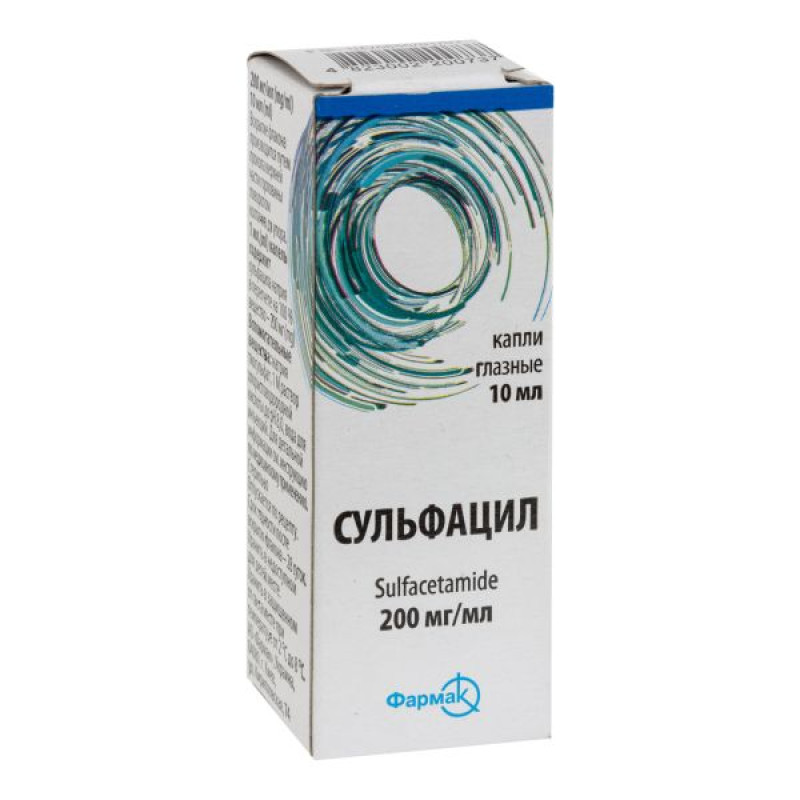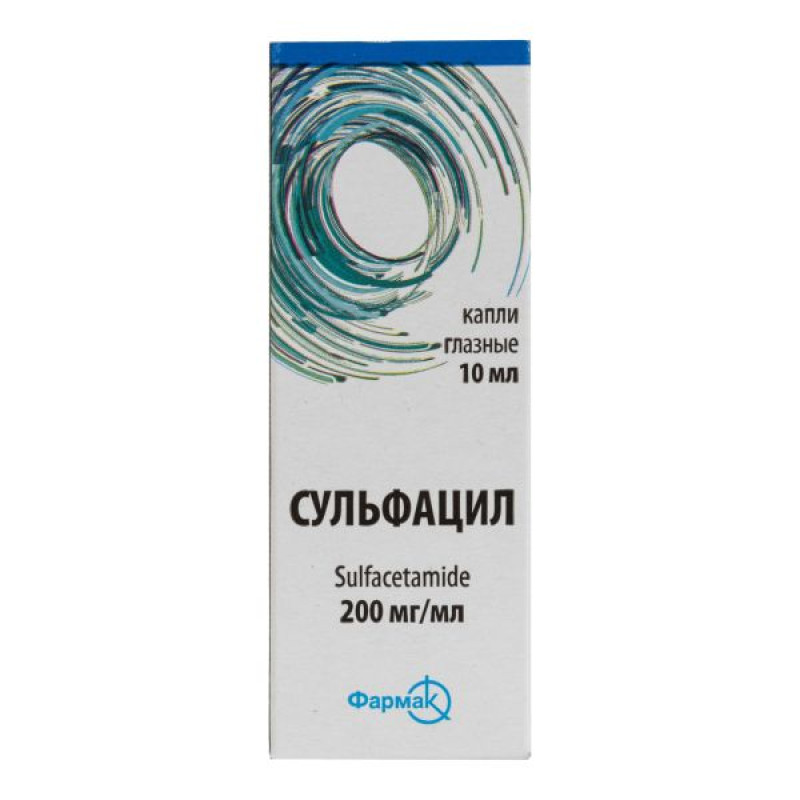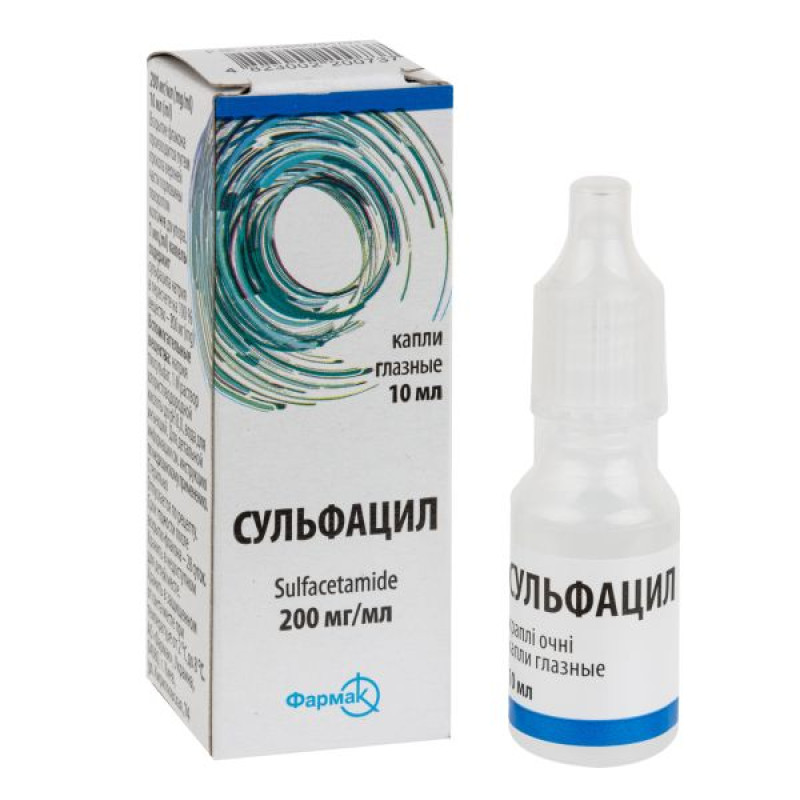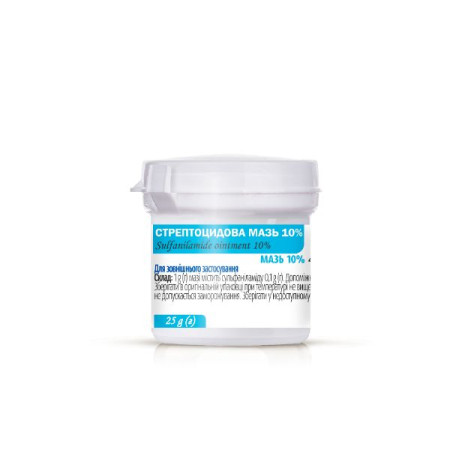Sulfacyl sodium eye drops 200 mg/ml bottle 10 ml

Instructions for use Sulfacyl sodium eye drops 200 mg/ml bottle 10 ml
Composition
active ingredient: 1 ml of solution contains 300 mg of sodium sulfacetamide;
excipients: sodium thiosulfate, water for injection, hydrochloric acid (to adjust pH).
Dosage form
Eye drops.
Main physicochemical properties: colorless or slightly colored transparent liquid.
Pharmacotherapeutic group
Drugs used in ophthalmology. Sulfonamides.
ATX code S01A B04.
Pharmacological properties
Pharmacodynamics.
Antimicrobial agent of the sulfonamide group. It has a bacteriostatic effect on gram-positive and gram-negative bacteria - streptococci, pneumococci, gonococci, Escherichia coli. The mechanism of action is associated with competitive antagonism with para-aminobenzoic acid and competitive inhibition of dihydropteroate synthetase, which leads to disruption of the synthesis of tetrahydrofolic acid, necessary for the synthesis of purines and pyrimidines. As a result, the synthesis of nucleic acids (DNA, RNA) of bacterial cells is disrupted and their reproduction is inhibited.
Pharmacokinetics.
When instilled into the conjunctiva, the drug penetrates into the ocular environment, where it exerts its specific antibacterial effect. It acts mainly locally, but part of the drug is absorbed through the inflamed conjunctiva and enters the systemic bloodstream.
Indication
Infectious-inflammatory eye diseases caused by microflora sensitive to the drug (conjunctivitis, keratitis, blepharitis, purulent corneal ulcers, blenorrhea).
Contraindication
Hypersensitivity to the components of the drug and other sulfonamides.
Interaction with other medicinal products and other types of interactions
When used together with novocaine, dicaine, anestezin, the bacteriostatic effect decreases; diphenyl, salicylates increase the toxicity of "Sulfacyl sodium"; when used with indirect anticoagulants, the specific activity of the latter increases. "Sulfacyl sodium" is incompatible with silver salt preparations when used locally.
Application features
For topical use only! Rare cases of death have been reported as a result of serious reactions to sulfonamides, including Stevens-Johnson syndrome, toxic epidermal necrolysis, fulminant hepatic necrosis, agranulocytosis, aplastic anemia, and other blood disorders.
Sensitization may occur when sulfonamides are administered repeatedly, regardless of the route of administration. Hypersensitivity reactions have been reported in individuals without a history of hypersensitivity to sulfonamides. At the first sign of hypersensitivity, skin rash, or other serious reactions, the use of this medicinal product should be discontinued.
Prolonged use of topical antibacterial agents may lead to overgrowth of pathogenic microorganisms, including fungi, and to the development of bacterial resistance to sulfonamides. The effectiveness of sulfonamides is reduced in the presence of high concentrations of para-aminobenzoic acid in purulent exudate.
Sensitization may occur with repeated administration of sulfonamides or as a result of cross-sensitivity between different sulfonamides.
At the first signs of hypersensitivity, increased purulent discharge, or increased inflammation or pain, the patient should discontinue use of the drug and consult a doctor.
Patients with hypersensitivity to furosemide, thiazide diuretics (hydrochlorothiazide), sulfonylurea derivatives (glibenclamide), carbonic anhydrase inhibitors (diacarb) may have hypersensitivity to "Sulfacyl Sodium".
During treatment with the drug, it is advisable to refrain from wearing contact lenses. Otherwise, contact lenses should be removed before using the drug and put back on no earlier than 15 minutes after instillation of the drug.
Use during pregnancy or breastfeeding
Animal studies have not been conducted on the ophthalmic use of sulfonamides. Kernicterus may occur in newborns as a result of oral sulfonamides taken by a woman during pregnancy or breastfeeding. There are no adequate and well-controlled studies of the use of ophthalmic sulfonamides by pregnant women, and it is not known whether sulfonamides can cause fetal harm when administered to a pregnant woman. "Sulfacyl sodium" should be used during pregnancy or breastfeeding as directed by a physician if the expected therapeutic effect outweighs the risk of possible adverse reactions.
Ability to influence reaction speed when driving vehicles or other mechanisms
Not studied.
As with other topical ophthalmic drugs, temporary blurred vision or other visual disturbances may affect the ability to drive or use machines. If blurred vision occurs during instillation, the patient should wait until vision clears before driving or using machines.
Adults should instill 2–3 drops of the drug into the affected eye 5–6 times a day. The course of treatment is determined by the doctor individually, on average it is 7–10 days.
Children. The safety and effectiveness of the drug "Sulfacyl sodium", eye drops 30%, in children have not been established.
Overdose
Significant irritation of the mucous membrane of the eye is observed; in such cases, the use of the drug should be discontinued immediately. If necessary, symptomatic treatment should be prescribed.
Adverse reactions
Bacterial and fungal corneal ulcers have been reported during treatment with sulfonamide ophthalmic drugs.
The most frequently reported reactions were local irritation, tingling and burning. Less frequently reported reactions included non-specific conjunctivitis, conjunctival hyperemia, secondary infection and allergic reactions.
Rare cases of fatality due to severe reactions to sulfonamides, including Stevens-Johnson syndrome, toxic epidermal necrolysis, fulminant hepatonecrosis, agranulocytosis, aplastic anemia, and other blood disorders, have been reported.
In some cases, irritation of the eye tissues (redness, itching, eyelid swelling, burning) is possible.
Expiration date
2 years.
After opening the bottle – 20 days.
Do not use after the expiry date stated on the packaging.
Storage conditions
Store in the original packaging to protect from light at a temperature of 2 to 8 °C.
Keep out of reach of children.
Packaging
10 ml of 30% solution in a plastic bottle. 1 bottle in a cardboard box.
Vacation category
According to the recipe.
Producer
LLC "FZ "BIOPHARMA", Ukraine.
Location of the manufacturer and its business address
Ukraine, 09100, Kyiv region, Bila Tserkva, Kyivska st., 37.
There are no reviews for this product.
There are no reviews for this product, be the first to leave your review.
No questions about this product, be the first and ask your question.










